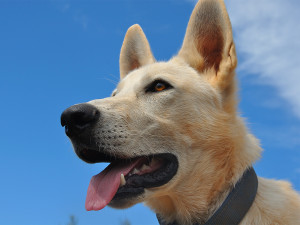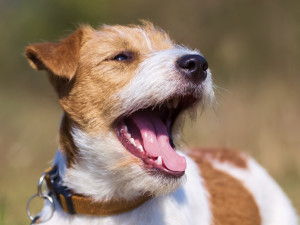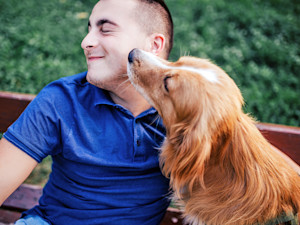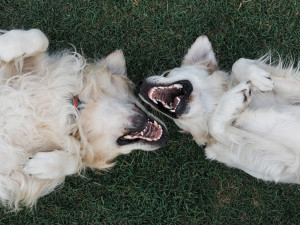Can Puppies Lose Their Teeth? Baby Teeth In Puppies
Whether you should save them for the tooth fairy is another issue entirely

Share Article
In This Article:
When Do Puppies Lose Their Baby Teeth? Do Puppies Swallow Their Baby Teeth? Signs of Puppy Teething Puppy Teething Timeline Promoting Healthy Adult Teeth Frequently Asked Questions
Just as human babies grow teeth that later fall out to make room for adult teeth, puppies develop a temporary set of teeth that start to shed around 12 to 16 weeks of age. During this teething stage, puppies may swallow the small baby teeth unnoticed.
When do puppies lose their baby teeth?
Over their lifetime, dogs will have two sets of teeth: 28 deciduous (baby) teeth and 42 adult teeth. While the exact timeline for growing and losing teeth varies from dog to dog, most dogs will start to get their first baby teeth around three to four weeks of age. A full set of deciduous teeth can be expected between six and eight weeks of age. Deciduous teeth tend to erupt in this order:
canines
incisors
premolars
Puppies will start to lose their baby teeth when they’re about 12 weeks old and usually have all of their adult teeth by five to seven months of age. Adult dog teeth tend to come in this order:
incisors
canines
premolars
molars
Do puppies swallow their baby teeth?
Puppies swallowing their baby teeth is very common and very normal. Most puppy parents don’t witness their puppy losing a single baby tooth. Some puppy parents may find a stray baby tooth on the floor or a small spot of blood on a teething toy. But more often than not, puppies will swallow their baby teeth and their people are none the wiser.
Is swallowing baby teeth bad for a puppy?
Puppies swallow most (and sometimes all) of their baby teeth without any issues. Swallowing baby teeth will not make puppies sick. If you’re worried your puppy is sick due to signs like pain, decreased appetite or vomiting, forget about their baby teeth and contact your vet.
Signs of puppy teething
A puppy’s baby teeth are much more sharp than their adult teeth, so puppies can do a lot of damage while teething. The entire teething process – from the first canine tooth to the last adult molar – can last between seven and eight months.
Those seven months can be a whirlwind for new puppy parents as their pups are busy exploring the world with their mouths. Puppies exhibit excessive chewing for a variety of reasons, including teething, playfulness, curiosity and boredom. Signs that a puppy is teething include:
excessive chewing
red and inflamed gums
drooling
slow, careful chewing
missing teeth
lethargy
Puppy teething timeline
A puppy’s mouth will go through a lot of changes during the first year of life. Puppies go from being completely toothless to growing sharp baby teeth, to replacing those teeth with their forever teeth. Here’s a general timeline of development:
Incisors
Incisors are the tiny teeth at the front of a dog’s jaw. They are used for nibbling, grasping and grooming.
baby incisors erupt: four to six weeks
baby incisors fall out: 12 to 16 weeks
adult incisors erupt: four to five months
Canines
Canines are the sharp, pointed teeth located next to the incisors. They are used for tearing and holding on to objects.
baby canines erupt: three to four weeks
baby canines fall out: four to five months
adult canine erupt: five to six months
Premolars
Premolars are located behind the canine teeth. They have flatter surfaces and are used for shearing and tearing.
baby premolars erupt: four to six weeks
baby premolars fall out: six months
adult premolars erupt: four to seven months
Molars
Molars are the large teeth located at the back of a dog’s jaw. They are used for crushing and grinding. Most puppies don’t notice the majority of their adult teeth erupting but as the molar teeth are the largest, it is often at this stage that pet parents notice their puppy moving items to the back of their mouth to chew – helping alleviate discomfort.
molars aren’t part of puppy dentition, so there are no baby molars
adult molars erupt: four to seven months
Possible puppy dental issues
Puppy parents should focus on providing plenty of puppy-safe toys for pups to chew on and use positive reinforcement to steer them towards those toys and away from your shoes. Puppies don’t know the difference between shoes they are allowed to chew and shoes they aren’t allowed to chew, so to protect your prized trainers, make the rule that all shoes are off-limits. And teach the humans in the house to put their shoes out of reach of the puppy.
Even though baby teeth don’t stay around for long, they can have issues. These puppy teeth problems often require veterinary attention.
Broken deciduous teeth
Some people’s first thought if a puppy cracks a tooth may be, ‘Well, it’s going fall out anyway,’ but this is the wrong approach. Puppy tooth roots are longer, so a cracked baby tooth is more likely to result in an exposed tooth root. This can leave a puppy susceptible to infection and a world of pain. If a puppy breaks a tooth, a veterinarian may recommend dental X-rays to determine the extent of the damage.
Delayed eruption of deciduous teeth
While most puppies grow their baby teeth like clockwork, sometimes a tooth might be a bit late to the party. This delay can occur due to dense tissue covering the tooth, blocking the tooth’s eruption. Delayed eruption of baby teeth can result in abnormal gingiva (where the tooth is trying to come up) or cyst formation. Delayed tooth eruption is more common in small-breed dogs.
Retained deciduous teeth
A puppy may get all their baby teeth without any issues, but occasionally, some of those suckers don’t want to leave. Baby teeth that don’t fall out on schedule create a crowded environment for the adult teeth trying to come in. This can lead to bad positioning of the adult teeth and misalignment of the jaw. Retained deciduous teeth are most common with the canine teeth. Lift your pup’s lip regularly to check the canine tooth, if you notice that the adult tooth is present but you can still see the baby tooth next to it, call into your vets to have it checked.
How to promote healthy adult teeth
Dogs rely on their teeth for eating, grooming, playing and exploring, so dental health is important. Neglecting dental care in dogs can lead to infection, discomfort and pain. Pet parents should be proactive and take steps to keep their dog’s teeth healthy.
Check your dog’s teeth regularly: getting puppies used to certain sensations, like having their ears touched, paws held and mouth opened, will make veterinary visits and at-home care easier. Introduce your puppy to the idea of having their teeth inspected early.
Regular toothbrushing: use a dog-specific (or medium adult human) toothbrush and dog-specific toothpaste to brush your dog’s teeth regularly. Daily is ideal, but a few times a week can make a huge difference. It’s essential to use dog-specific toothpaste as human toothpaste is toxic to dogs.
Routine vet visits: schedule regular checkups with your vet. Your vet can assess your dog’s oral health and recommend interventions before dental disease becomes severe.
Professional dental cleanings: thorough dental cleanings are performed under general anaesthesia and can help remove the plaque and tartar that accumulate over time. This is also the time for problem teeth to be removed.
Permissible things to chew: both teething puppies and adult dogs have a natural desire to bite down on things but not all things are safe to do so. The enamel on a dogs teeth is surprisingly much thinner than human tooth enamel. In fact, dog’s enamel is six times thinner than our enamel. This, coupled with a stronger bite-force in their jaw and a craving to bite daft things puts their teeth in danger. The rule for giving them safe things to chew is simply, if you wouldn’t want to bite down on something yourself for fear of your teeth, then neither should your dog. Never let them chew antlers, bones, sticks, stones or anything hard. Instead, choose rubber toys, rope toys, soft toys or chew toys that can
flex and move so that when bitten, the item ‘gives’ instead of causing damage to the tooth.Healthy diet: growing puppies need extra nutrients to grow strong bones and teeth. Be sure to feed an age-appropriate diet for each of your dog’s life stages.
Frequently asked questions
How do I know if my puppy has gum disease?
Periodontal disease – or gum disease, as it’s known – can occur in puppyhood. Your puppy will have adult teeth that need daily care, erupting through the gums from four months of age, with a full set of adult teeth from about seven months old.
The bacteria on the teeth form an off-white, sticky layer called dental plaque. If the plaque isn’t removed, it hardens to form tartar (a brown, rough deposit on the teeth) within days. The bacteria within plaque and tartar attacks the gums and causes inflammation of the gum tissue. Plaque damages the gum tissues and then the other structures which attach the teeth (such as ligaments and bone). This is a painful process and if left untreated, the tooth will become loose and eventually fall out.
Dogs are stoic animals and they hide pain well, providing an oral care regime at home and having your pet’s mouth checked regularly by your vet or vet nurse, can help to prevent this condition.
Signs of gum disease or oral pain are: being less lively than normal, not wanting their head or face touched, drooling, rubbing their face on the floor or against furniture, pawing at their face, being reluctant to ear, redness of the gums and bad breath.
Do puppies have pain when losing teeth?
Teething can cause puppies occasional discomfort. Signs of pain associated with teething in puppies include slow/deliberate chewing, drooling, whining and lethargy. If a pup is in too much pain to eat, contact a vet to see if something else is going on as most puppies go through teething without even noticing it’s happening.
How do I take care of my puppy’s teeth?
Parents can help their teething puppies by providing appropriate teething toys. Puppy parents can also get their pups used to dental care by introducing toothbrushing early.
References:

Dr. Alycia Washington, DVM, MS
Alycia Washington, DVM, is a small animal emergency veterinarian based in North Carolina. She works as a relief veterinarianopens in new tab and provides services to numerous emergency and specialty hospitals. She also works as a veterinary writer with a focus on educating pet owners.
Related articles
![Photo of small terrier dog outside int he sun with mouth open, teeth and tongue visible]()
Do Small Dogs Have Bigger Dental Issues?
A new study finds that small dog breeds are at higher risk for dental disease
![Happy dog with teeth visible, blue sky background]()
Does Your Dog Need a Dentist?
NYC’s top veterinary dentist on bad breath, dental disease and brushing your dog’s teeth daily
![Man leaning away from dog's face outside.]()
Here’s Why Your Dog’s Breath Is the Worst
It might be a sign of a bigger issue
![a pair of English cream retriever dogs wiggle around on their backs with big grins on their faces]()
1 in 8 Dogs Has Dental Disease – Does Yours?
Here are four common dental problems your pup might face and how to treat them




